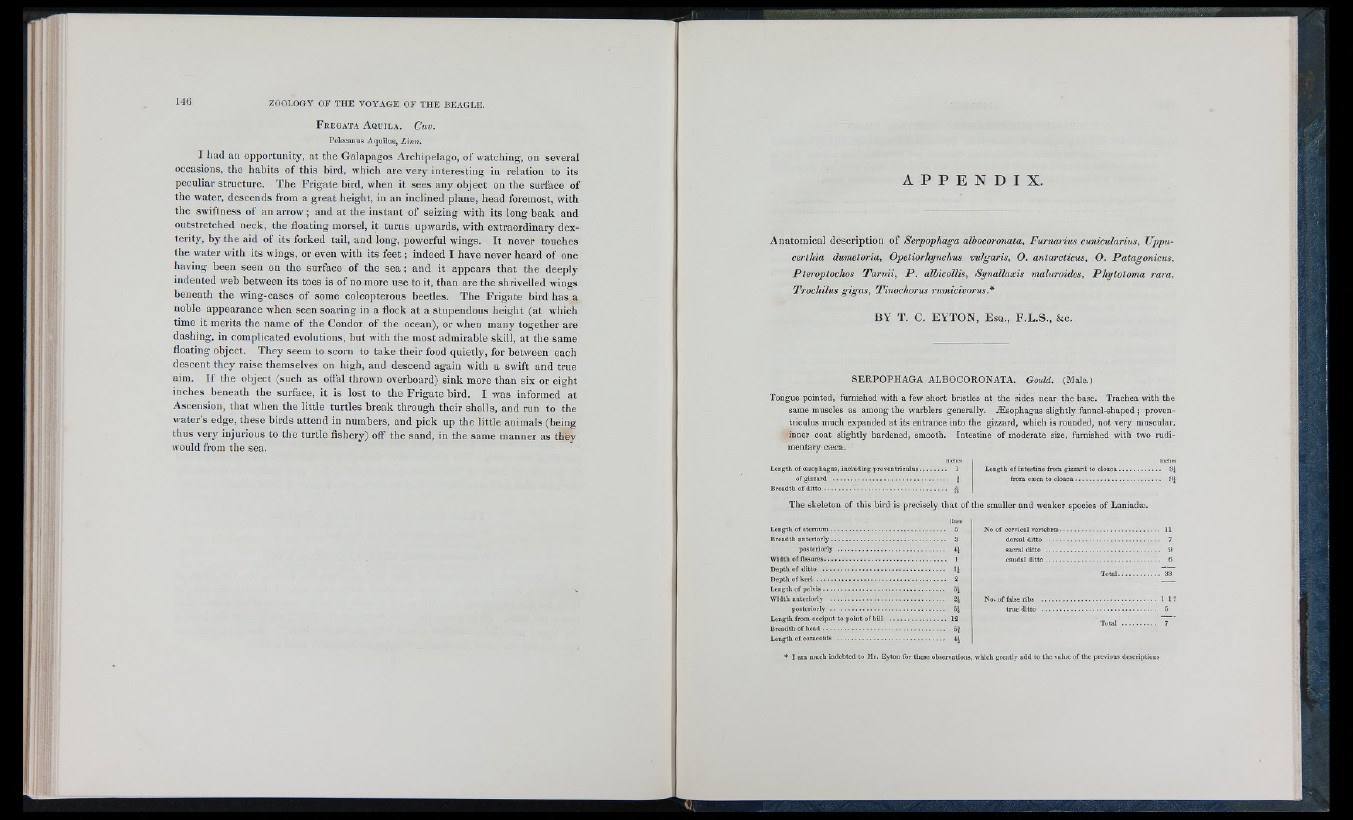
F r e g a t a A q u i l a , C uv.
Pelecanus Aquilus, Linn.
I had an opportunity, at the Galapagos Archipelago, o f watching, on several
occasions, the habits o f this bird, which are very interesting in relation to its
peculiar structure. The Frigate bird, when it sees any object on the surface o f
the water, descends from a great height, in an inclined plane, head foremost, with
the swiftness o f an arrow; and at the instant o f seizing with its long beak and
outstretched neck, the floating morsel, it turns upwards, with extraordinary dexterity,
by the aid of its forked tail, and long, powerful wings. It never touches
the water with its wings, or even with its f e e t ; indeed I have never heard o f one
having been seen on the surface o f the s e a ; and it appears that the deeply
indented web between its toes is o f no more use to it, than are the shrivelled wings
beneath the wing-cases o f some coleopterous beetles. The Frigate bird has a
noble appearance when seen soaring in a flock at a stupendous height (at which
time it merits the name o f the Condor o f the ocean), or when many together are
dashing, in complicated evolutions, but with the most admirable skill, at the same
floating object. They seem to scorn to take their food quietly, for between each
descent they raise themselves on high, and descend again with a swift and true
aim. I f the object (such as offal thrown overboard) sink more than six or eight
inches beneath the surface, it is lost to the Frigate bird. I was informed at
Ascension, that when the little turtles break through their she lls, and run to the
water’s edge, these birds attend in numbers, and pick up the little animals (being
thus very injurious to the turtle fishery) off the sand, in the same manner as they
would from the sea.
A P P E N D I X .
Anatomical description of Serpophaga albocoronata, Furnarius cunicularius, Uppucerthia
dumetoria, Opetiorhynchus vulgaris, O. atitarcticus, O. Patagonicus,
Pteroptochos Tarnii, P . albicollis, Synallaxis maluroides, Phytotoma rara,
Trochilus gigas, Tinochorus rumicivorus.*
B Y T. C. EY TO N , E sq., F .L .S ., &c.
SERPOPHAGA ALBOCORONATA. Gould. (Male.)
Tongue pointed, furnished with a few short bristles at the sides near the base. Trachea with the
same muscles as among the warblers generally. ^Esophagus slightly funnel-shaped; proven-
triculus much expanded at its entrance into the gizzard, which is rounded, not very muscular,
inner coat slightly hardened, smooth. Intestine of moderate size, furnished with two rudimentary
c£eca.
Inches
Length of oesophagus, including p ro v en tric u lu s ..
of gizzard .......................................................
B readth o f d i t t o .............................................................
Length of intestine from gizzard to c lo a c a ......................... 3^
from cajca to c lo a c a ..................................................... fq
The skeleton of this bird is precisely that of the smaller and weaker species of Laniadse.
No of cervical v e rteb rie ............................................................. 11
dorsal d i t t o ....................................................................... 7
sacral d itto ....................................................................... 9
caudal d i t t o ....................................................................... 6
T o ta l..
Length of s te r n um ....................................................................... 6
Breadtli a n te rio rly ....................................................................... 3
posteriorly ................................................................... 4^
W id th o f Assures........................................................................... 1
Depth of d itto ............................................................................ q
Dep th of k e e l ................................................................................ 2
Length of p e lv is ...........................................................................
Widtli anteriorly ....................................................................... 2^
posteriorly ....................................................................... 6^
L ength from occiput to p o in t o f bill ................................... 12
Breadth of h e a d ............................................................................ 5J
L ength of coracoids ................................................................... q
No. o f false ribs ...................................................................... 1 1 '
tru e d itto ....................................................................... 5
* I am much indebted to Mr. Eyton for these observations, which g reatly ad d to the value of the previous descriptioi